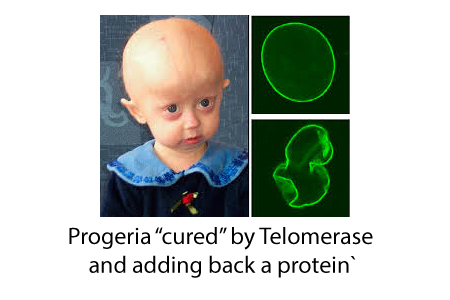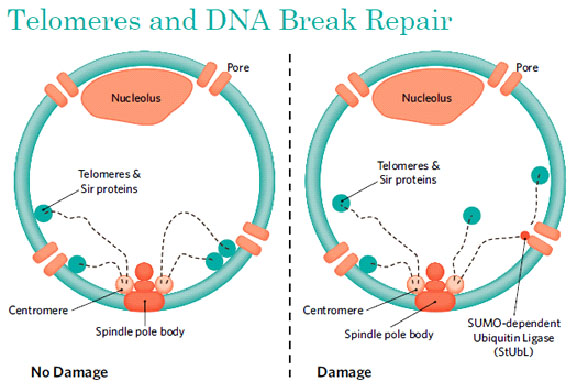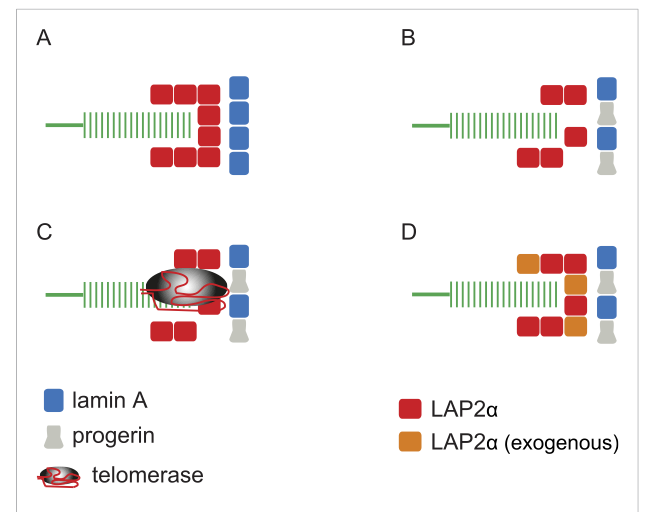
- Written:
- Author: Edward
- Posted in: age-related-diseases, research, Telomere erosion
- Tags: brca, chojnowski, Dr. Ed Park, dreesen, elife, hgps, lamin a, progeria, progerin, singapore, telomerase, telomere dysfunction, telomeres
HGPS (Hutchison Guilford Progeria Syndrome) is one of the classic premature aging syndromes that was associated with shortened telomeres but prior to this week, was thought to be primarily acting through nuclear membrane instability.
To produce natural HGPS in one in 4,000,000 people, a single sporadic Cytosine to Thymine mutation occurs at position 1824 within the patient’s LMNA gene (although there are two reported cases of parents who also carried the mutation and didn’t show the premature aging phenotype).
The gene dose for Lamin A (the gene encoded by LMNA) is 50% in progeric patients because half of the Lamin A produced by the cells is a mutant variant called Progerin.
Progerin doesn’t provide the same stability for the inner nuclear membrane; that we knew. But this new study showed that the reason for the premature aging and telomere erosion is that the progerin doesn’t bind well with Lamin-Associated Polypeptide-2, alpha form, which in turn, binds the telomeres and keeps them organized.
A very important study by Chojnowski et al in ELife was published yesterday (click for full citation) showing that HGPS was caused by a weak interaction of the Progerin (mutant Lamin A) with LAP2α as illustrated here. LAP2α is what 50% of the telomeres tether to.
In the normal figure A, there is normal blue Lamin A (two normal genes of LMNA). In HGPS figure B, there is one copy of mutated LMNA (i.e. Progerin) that is shown in grey and doesn’t bind well to the LAP2α
Simply stated, their model showed that they could “cure” their HGPS mouse model by two two things. In figure C, they added telomerase activity. In figure D, they added a little extra LAP2α.
There are many who feel that telomeres and telomerase are not centrally related to aging. This study shows that for at least this classic model of premature aging, Suttons’s Law still applies. For those who don’t recall, Willie Sutton was a bank robber and when he was asked why he robbed banks, he replied:
Why do telomeres even want to tether to the inside nuclear membrane? Telomeres are the handlebars of the chromosomes.

Without tethering, chromosomes would flop around like pasta in the pot rather than webs of a spider web. That’s why the BRCA2 (inappropriately named breast cancer gene) mutated confers high rates of cancer; BRCA2 is also involved with telomere handling and maintenance.
If you want to understand more about premature aging, please check out this 11-minute video I did on the subject.





3 thoughts on “Premature aging linked to telomeres – cure found”
I’ve read Timebombs 2x and am just starting the 3rd go-around. Hope to talk with you soon.
Thanks,
Rafael M. Irizarry
American Composer
Miami, Florida
(305) 515-6043 RES
Pingback: Archives 16 – Sept 10th, 2022 – Recharge Biomedical
Being a retired nurse, I am amazed at how far medical research has come. Thank God and these amazingly dedicated medical researchers for finding a way to help reverse the pre-mature aging when caught soon enough. Bless those incredible doctors and researchers dedicated to helping stop the damage done by premature aging.